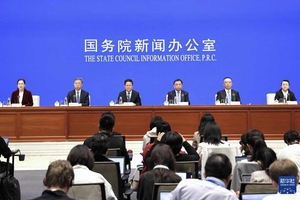Commentary: Where the Money Needs to Go to Spur on China’s Growth
Listen to the full version


China has announced a range of monetary stimulus measures in September to boost the economy. Now, market expectations are building around the possibility of a massive fiscal stimulus package, with some speculating it could exceed 10 trillion yuan ($1.4 trillion).
However, we think it may be more reasonable to expect a more modest package of 1.5 to 2 trillion yuan in the near term, while another 2 to 3 trillion yuan of fiscal expansion on top of what we have already assumed in our earlier baseline forecast could be expected in 2025.

Download our app to receive breaking news alerts and read the news on the go.
Get our weekly free Must-Read newsletter.
- DIGEST HUB
- China's monetary stimulus measures in September 2023 could lead to a fiscal package from 1.5 to 2 trillion yuan, with potential further expansion in 2025.
- Key fiscal needs include addressing a 1.3 trillion yuan revenue gap, local government debt restructuring, and social welfare spending, among other sectors.
- GDP growth is projected at 4.6% in 2024 and 4.0% in 2025, with potential to increase if further fiscal support is implemented.
[para. 1] China has implemented monetary stimulus measures in September aimed at bolstering its economy. Speculation is rising about the possibility of a significant fiscal stimulus package that could surpass 10 trillion yuan ($1.4 trillion).
[para. 2][para. 3] However, expectations for a large package may be tempered. Analysts suggest a more modest fiscal stimulus between 1.5 to 2 trillion yuan could emerge shortly, with an additional 2 to 3 trillion yuan expected in 2025. Projections for the second half of 2024 indicate a fiscal expansion of 1 to 1.2 trillion yuan, equating to about 0.3-0.4% of GDP. A 2025 baseline scenario assumes fiscal expansion at 1% of GDP, incorporating 1.5 trillion yuan in special treasuries and about 4 trillion yuan in special local government bonds.
[para. 4] A fiscal stimulus package for 2024 might be announced post-October holiday or in conjunction with third-quarter data disclosures on October 18. Potential 2025 measures could be decided during the Central Economic Work Conference in December.
[para. 5][para. 6] September saw policies to support China’s capital markets and real economy, including rate cuts, easing of property market conditions, and new monetary tools to stabilize stock markets. Despite ongoing fiscal restraint, governmental intent to provide further policy support was suggested during a Politburo meeting on September 26, leading to varying stimulus estimates from 2 to 10 trillion yuan, equating to 1.6% to 8% of GDP.
[para. 7][para. 8] A large-scale stimulus is expected to address financing issues and debt burdens of local governments, inject capital into state-owned banks, and support households and corporates through heightened social spending and subsidies.
[para. 9] The exact quantum of fiscal stimulus needed hinges on growth goals; achieving near 5% GDP growth in 2024 could necessitate swift implementation of a 1.5 to 2 trillion yuan package.
[para. 10] To stabilize the real estate market and boost confidence aiming for near 5% growth by 2025 will require greater fiscal measures, plus structural reforms.
[para. 11] Potential fiscal needs include filling a 1.3 trillion yuan fiscal revenue gap, restructuring local government debt, enhancing social spending, providing consumption subsidies, and addressing housing inventory.
[para. 13][para. 14] While a considerable fiscal package may be necessary, funding constraints suggest reliance on central government bonds and cautious fiscal planning. Addressing financing difficulties, supporting social initiatives, and relieving debt burdens through targeted interventions are likely.
[para. 15] If a 1.5 to 2 trillion fiscal stimulus is executed, 2024 GDP could rise to 4.8%. Stronger property market support in 2025 might further boost GDP growth to 4.5%, barring external factors like tariff hikes.
[para. 16] As fiscal and monetary policies ease, the yuan might strengthen, potentially hitting 6.9 against the U.S. dollar in 2024 and 6.8 in 2025.
[para. 17][para. 18] This analysis, authored by Wang Tao, reflects UBS Investment Bank views and not necessarily those of Caixin Media. Caixin welcomes contributions and perspectives via their opinion section email.
- UBS Investment Bank
- UBS Investment Bank is a global financial institution that provides financial services, including investment banking, wealth management, and asset management. Wang Tao, the chief China economist at UBS, authored the article providing analysis and forecasts on China's economic stimulus measures and their potential impacts on GDP growth and fiscal policy.
- PODCAST
- MOST POPULAR







 Sign in with Google
Sign in with Google
 Sign in with Facebook
Sign in with Facebook
 Sign in with 财新
Sign in with 财新